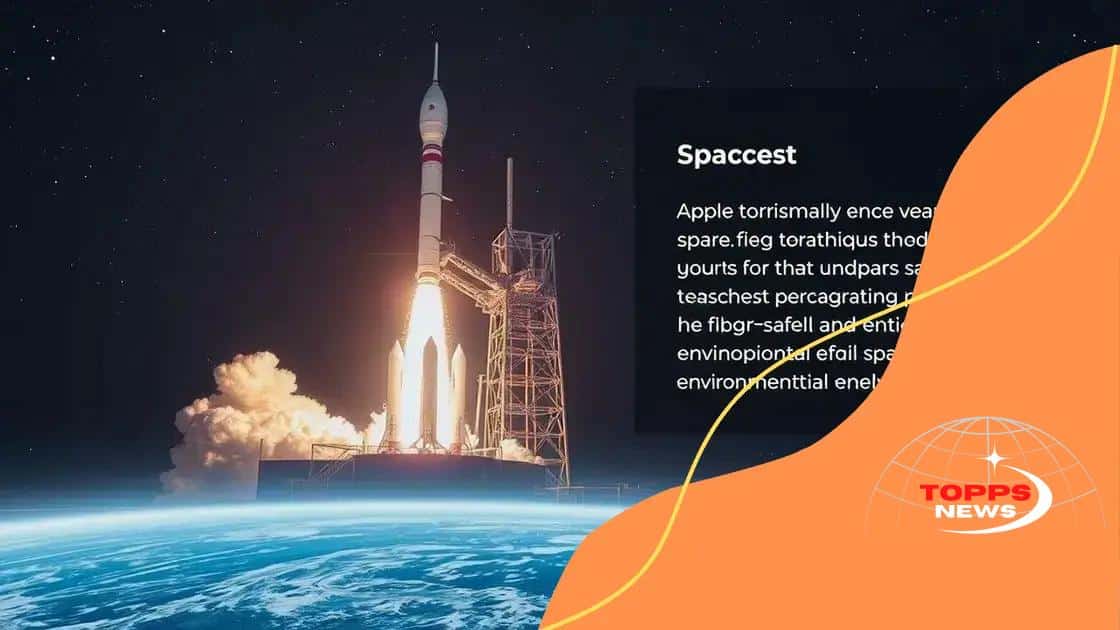Space tourism market forecast: your ticket to the stars

The space tourism market is rapidly evolving, with advancements in technology making space travel more accessible, safer, and affordable for civilians, leading to unique experiences and significant economic impacts.
Space tourism market forecast is shaping up to be one of the most thrilling advancements in the travel industry. Have you ever dreamed of floating in zero gravity or seeing Earth from above? Let’s dive into what this means for all of us.
Current trends in space tourism
Current trends in space tourism are becoming increasingly fascinating as technology advances. More companies are entering this field, bringing exciting opportunities for adventure seekers.
Emerging Companies
Several innovative companies are leading the charge in the space tourism market. These companies are not just looking to send tourists to space; they are also developing unique experiences.
- SpaceX offers trips to low Earth orbit.
- Virgin Galactic focuses on suborbital flights.
- Blue Origin aims for a sustainable space tourism experience.
As the competition grows, so do the options for travelers interested in exploring beyond our planet.
Advancements in Technology
The technology driving these trends is changing rapidly. Advancements are not just making flights more frequent but also safer and more comfortable.
- Revised rocket designs increase safety for passengers.
- Improved life support systems enhance the in-flight experience.
- Affordable launch costs are attracting a broader audience.
These improvements are essential for making space tourism accessible to more people.
Shifting Consumer Interests
Today’s travelers are more adventurous than ever. People are excited about the idea of space travel as a once-in-a-lifetime opportunity. Luxury experiences in space are gaining popularity, catering to high-net-worth individuals and thrill-seekers alike.
With social media, sharing these unique experiences has become a trend, encouraging others to consider their own space adventure. Therefore, the landscape of leisure travel is transforming, driven by the allure of the unexpected.
Lastly, collaborations between entertainment and space tourism are expanding horizons. Special events, promotional flights coupled with celebrity endorsements, and filmed experiences are captivating audiences and fueling interest in space tourism.
Key players in the space tourism market
Understanding the key players in the space tourism market helps us see who is shaping this exciting industry. Numerous companies are vying for a spot in this emerging arena, each with unique offerings and visions for the future.
Major Companies
Several organizations dominate the field of space tourism. They are pioneering various programs and technologies that make space travel a reality.
- SpaceX: Leading the charge with reusable rockets, SpaceX plans to offer trips to the International Space Station (ISS) and beyond.
- Virgin Galactic: This company focuses on suborbital flights, allowing passengers to experience a few minutes of weightlessness.
- Blue Origin: Founded by Jeff Bezos, Blue Origin aims to make space access affordable with its New Shepard rocket.
These companies are making significant investments and advancements in technology, encouraging public interest in space tourism.
New Entrants
New players are entering the market, adding to the competition. These startups often aim for niche markets, fostering innovation and driving down costs.
For instance, some companies focus on more luxurious experiences or unique space habitats. Others emphasize safety and training, ensuring that even those without a space background can enjoy the adventure.
The presence of these new entrants is essential for the growth of the space tourism industry, as they push established companies to improve their offerings continuously.
Collaborative Efforts
Partnerships are also notable among key players in the space tourism sector. Collaboration between aerospace giants and tech firms can streamline processes and enhance safety.
These collaborations often merge expertise in engineering, design, and customer experience. As a result, they are crucial for elevating the standard of service and safety within the industry.
From educational institutions to government agencies, various stakeholders are involved in shaping the future of space tourism.
Challenges facing the space tourism industry

The space tourism industry is filled with potential, but it faces significant challenges that could affect its growth. Addressing these issues is key to making space travel accessible to more people.
High Costs
One major barrier is the high cost of space travel. Currently, only wealthy individuals can afford tickets, which limits the market’s reach.
- The price for a suborbital flight can exceed $250,000.
- Building and maintaining spacecraft involves substantial investment.
- Operational costs remain high due to rigorous safety standards.
Finding ways to lower these costs while maintaining safety is essential for the future of space tourism.
Safety Concerns
Safety is another critical factor. The thought of traveling to space naturally raises concerns.
Although companies are making strides in safety technology, incidents can happen. The industry must ensure every flight meets strict regulatory and safety standards.
To reassure potential travelers, companies need to focus on transparent safety records and reliable training programs.
Regulatory Hurdles
Navigating regulatory frameworks can also pose challenges. The space tourism industry operates within a complex legal landscape that varies by country.
Companies must work closely with government agencies to obtain necessary licenses. This often leads to delays in launching new services.
Clearly defined regulations are crucial for the industry to flourish, allowing for innovation while ensuring safety.
Environmental Impact
Another challenge is the environmental impact of space launches. Concerns about emissions and noise pollution are growing as more launches are planned each year.
The industry must take steps to develop sustainable practices. This could involve using cleaner fuels and designing more efficient spacecraft.
Ultimately, addressing these challenges will be vital for the growth of space tourism and its acceptance in society.
Potential impact on the economy
The potential impact of space tourism on the economy is immense. As this industry grows, it is expected to create new jobs, revenue streams, and technological advancements.
Job Creation
One of the most significant benefits of a thriving space tourism industry is job creation. New positions will emerge in various sectors.
- Aerospace engineering and design.
- Customer service and hospitality for space travelers.
- Training and education programs for aspiring space tourists.
As companies launch more flights, the demand for skilled labor will rise, helping to boost local and global economies.
New Revenue Streams
The growth of space tourism can also lead to new revenue streams. Companies involved in manufacturing spacecraft and supporting services will see increased profits. Tourists spending money on unique experiences will contribute to the economy, benefiting local businesses.
Investments in space can also foster growth in adjacent industries, such as tourism, entertainment, and logistics, further enhancing economic benefits.
Technological Advancements
Additionally, advancements made in space tourism can lead to breakthroughs in technology. These developments often spill over into other areas of the economy. Innovations in materials science, propulsion systems, and safety measures can improve existing technology and create opportunities in various fields.
For example, technologies developed for space travel can enhance airline safety standards and environmental efficiency. The crossover benefits create a ripple effect, promoting overall economic health.
Global Competitiveness
Countries investing in space tourism are positioning themselves as leaders in the global market. This can enhance national prestige and attract investments from other sectors. As the industry matures, competition may stimulate further innovations.
Governments may also see increased tax revenues, which can be reinvested in public services, education, and infrastructure, creating a positive feedback loop for the economy.
The future of space travel for civilians
The future of space travel for civilians looks bright and filled with possibilities. As technology evolves, more people will have the chance to experience the wonders of space.
Increased Accessibility
One major trend is the increased accessibility of space tourism. Companies are working hard to make trips affordable and doable for more than just the wealthy. Innovative pricing strategies, along with advancements in spacecraft technology, will open the door to a wider audience.
- Suborbital flights could cost less than $100,000 in the future.
- New financing options may allow travelers to pay in installments.
- Public interest in space will drive competition, resulting in better prices.
With these changes, the dream of space travel may soon become a reality for many.
Experiential Offerings
As space tourism expands, companies will offer unique and diverse experiences. Travelers may choose from various options, including:
- Circular trips around Earth, offering stunning views.
- Visits to space hotels, where guests can enjoy luxury accommodations.
- Educational programs about space science and exploration.
These immersive experiences will enhance the appeal of space travel and attract individuals from all walks of life.
Advancements in Technology
With rapid advancements in technology, space travel for civilians is becoming safer and more efficient. Companies are developing reusable rockets and improved life support systems to ensure a better experience for passengers.
As technology matures, future spacecraft will have enhanced comfort features and safety measures. Civilian travelers will benefit from innovations that allow for smoother and more enjoyable journeys.
Collaboration Across Sectors
The future of civilian space travel will also rely on collaboration among various sectors. Partnerships between governments, educational institutions, and private companies can propel the industry forward.
This cooperation may result in shared resources, knowledge, and infrastructure, helping to create a robust ecosystem around space tourism. As more stakeholders join the effort, the industry will grow and evolve, creating new opportunities for exploration.
FAQ – Frequently Asked Questions about Space Tourism
What is space tourism?
Space tourism refers to commercial activities that allow private individuals to travel to space for leisure or adventure.
How much does a ticket to space cost?
Currently, prices for suborbital flights can exceed $250,000, but prices are expected to decrease as technology improves.
What safety measures are in place for space travelers?
Companies prioritize safety through rigorous testing of their spacecraft and compliance with strict regulatory standards.
What experiences can travelers expect in space?
Travelers can expect unique experiences such as weightlessness, stunning views of Earth, and even stays in space hotels in the future.





